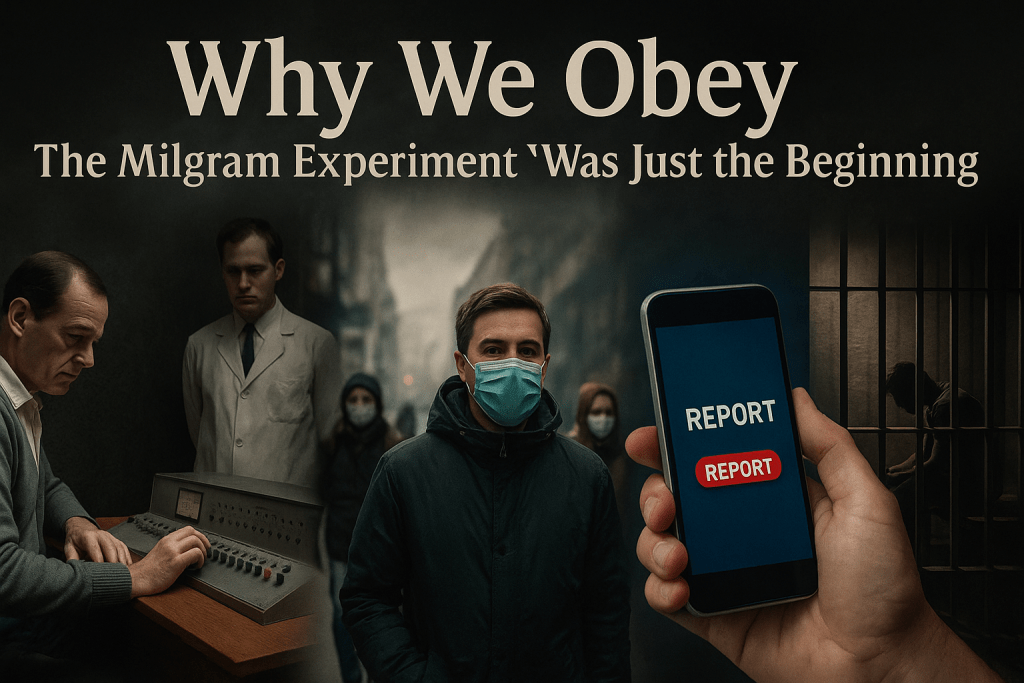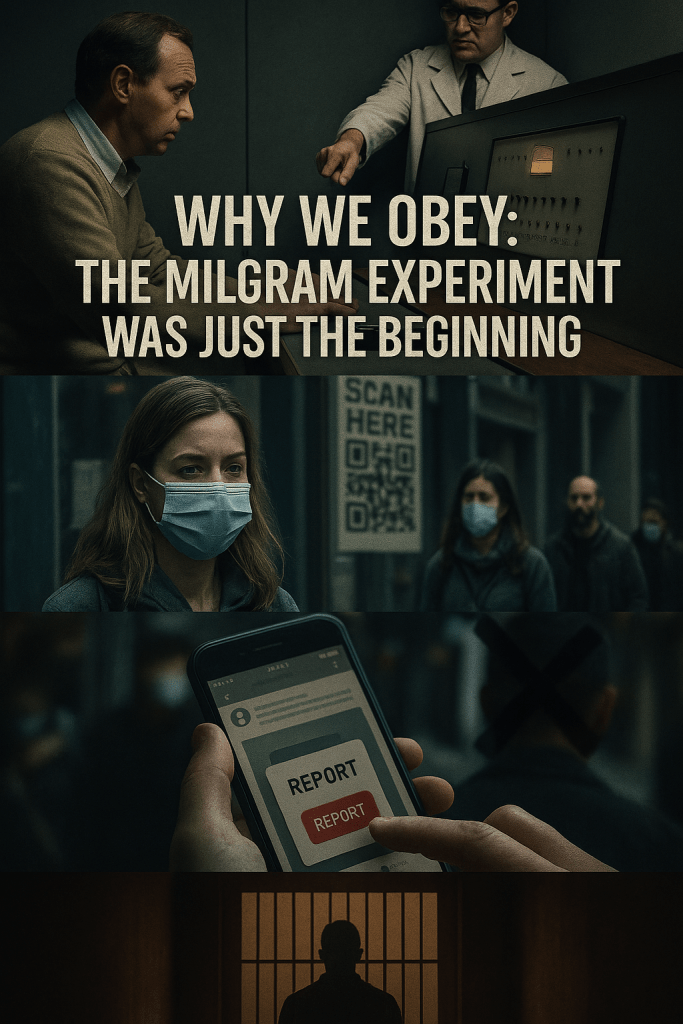Part I: The Experiment That Shocked the World
Yale, 1961.

The volunteer, a middle-aged man in a cardigan, sits nervously at a desk.
In front of him: a panel of switches marked with increasing voltage—from 15 to 450 volts.
A man in a white lab coat stands behind him, clipboard in hand, calm and authoritative.
“Please continue,” the man says.
“The experiment requires that you go on.”
Behind the wall, the “learner” screams.
At 150 volts: “I want to stop!”
At 270 volts: “Let me out! My heart hurts!”
At 330 volts: silence.
The subject turns to the man in the lab coat. He’s sweating. His hand trembles over the next switch.
“I think he’s unconscious.”
“Please continue.”
“But what if I kill him?”
“I take full responsibility.”
He presses the button.
That scene wasn’t fiction.
It was the Milgram experiment, and it revealed something chilling:
Ordinary people, with no personal grudge, will deliver what they believe is a fatal shock—because someone told them to.
Sixty-five percent did.
They weren’t sociopaths. They were us.
Part II: The Lockdown Mindset
March 2020.
You wake up. Your city is silent.
You’re told not to go outside. You comply.
A notification buzzes: “New mask mandate.” You put it on.
At the store, signs read:
“One cart per household.”
“6 feet apart.”
“Follow arrows.”
Someone sneezes. The aisle clears.
Soon, people begin reporting neighbors for hosting dinner.
Surveillance drones fly over parks.
A man is dragged off a bus in Philadelphia for not wearing a mask.
In Melbourne, police knock on a pregnant woman’s door—for sharing a protest flyer on Facebook.
She’s arrested in front of her children.
The camera catches her saying:
“But I didn’t even go to the protest yet.”
And no one around says a word.
Milgram’s white lab coat has changed.
Now it’s the branding on a press conference podium.
A blue checkmark.
A “fact-check” badge.
A sterile infographic that says:
“We’re all in this together. Comply.”
And millions did.
Part III: Obedience in the Age of Algorithms
Today’s orders don’t come from men in uniforms.
They come from interfaces.
You see a post that challenges the narrative—
below it, a warning: “This contains misinformation.”
You hesitate to share it.
Your friend loses their job for refusing the booster.
You whisper your own doubts in DMs—but not on your feed.
On YouTube, a new documentary is uploaded.
The like button is gone. Comments disabled.
The algorithm buries it.
Instead, it recommends “Why Vaccine Skeptics Are Dangerous.”
You press the report button on a tweet—just to be safe.
The next day, that account disappears.
You forget about it.
We’re not forced to obey.
We’re nudged.
We don’t say “I was just following orders.”
We say,
“I was just doing what everyone else was doing.”
“I didn’t want to cause trouble.”
“It wasn’t my place.”
The interface is the new authority.
And every click is a little act of obedience.
Part IV: When Obedience Kills
Abu Ghraib, 2003.
American soldiers smile in photos as they pose beside tortured Iraqi prisoners.
They say: “We were just following procedures.”
Nazi Germany, 1940s.
Doctors sterilize patients, perform deadly experiments.
They say: “We were following state science.”
Facebook, 2021.
A woman posts her son died after the second shot.
Her post gets flagged, then deleted.
She says: “I just wanted people to know.”
No one is “doing evil” in their mind.
They’re simply… participating.
Delegating responsibility.
Obeying the system.
And when you obey long enough,
you forget how to stop.
Part V: What If You Said No?
In Milgram’s lab, a few subjects refused.
One turned to the man in the lab coat and said:
“I won’t do it. I don’t care who’s responsible.”
He walked out.
Today, walking out isn’t easy.
It might mean losing your account.
Your job.
Your social circle.
But it might also mean keeping your soul.
The next time you’re told,
“Just follow the policy.”
“Just click the button.”
“Just trust the science.”
Ask yourself:
What’s on the other side of the wall?
And who is about to be silenced—
because you pressed
one
more
button?

Vaccines and Microchips: Conspiracy, Control, or a Glimpse of the Future?